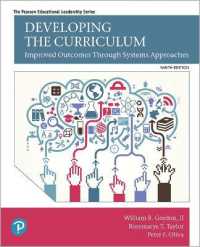- ホーム
- > 洋書
- > 英文書
- > Politics / International Relations
Full Description
National security has been at the forefront of the Israeli experience for seven decades, with threats ranging from terrorism, to vast rocket and missile arsenals, and even existential nuclear dangers. Yet, despite its overwhelming preoccupation with foreign and defense affairs, Israel does not have a formal national security strategy.
In Israeli National Security, Chuck Freilich presents an authoritative analysis of the military, diplomatic, demographic, and societal challenges Israel faces today, to propose a comprehensive and long-term Israeli national security strategy. The heart of the new strategy places greater emphasis on restraint, defense, and diplomacy as means of addressing the challenges Israel faces, along with the military capacity to deter and, if necessary, defeat Israel's adversaries, while also maintaining the resolve of its society. By bringing Israel's most critical debates about the Palestinians, demography, Iran, Hezbollah, Hamas, US relations and nuclear strategy into sharp focus, the strategy Freilich proposes addresses the primary challenges Israel must address in order to chart its national course.
The most comprehensive study of Israel's national security to date, this book presents the first public proposal for a comprehensive Israeli national security strategy and prescribes an actionable course forward.
Contents
Foreword and Acknowledgements
Acronyms
Major Wars and Military Operations
List of Maps, Tables, Figures
Part I
Introduction
1. Israel's Classic Defense Doctrine
Part II: A Strategic Environment Transformed
2. Israel's New Strategic Setting
3. The Changing Military Threat
4. Non-Military Threats
5. Israeli Society and National Security
Part III: Israel's Strategic Response
6. The Classic Military Response in Perspective
7. The Military Response Today
8. Nuclear and Regional Arms Control Policy
9. The Foreign Policy Response
10. The "Special Relationship"
Part IV: A National Security Strategy for an Era of Change
11. Primary Conclusions
12. Policy Recommendations
Appendix
List of Interviews
Bibliography
Notes
Index








